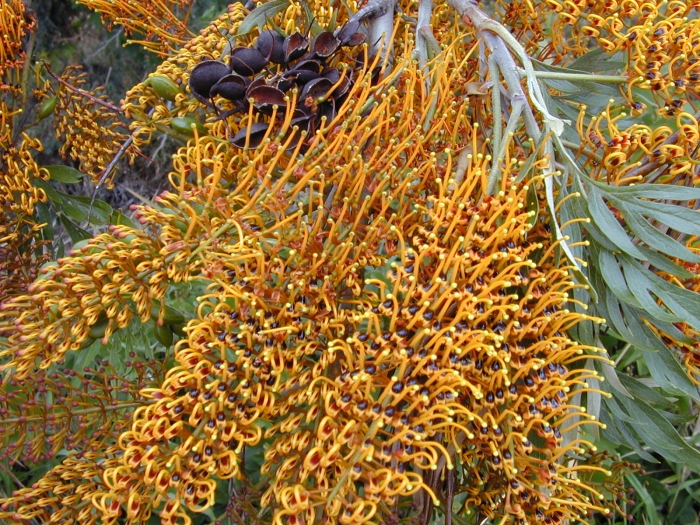Silky Oak
(Grevillea robusta)
Silky Oak (Grevillea robusta)
/
/

Forest and Kim Starr
CC BY 2.0
Image By:
Forest and Kim Starr
Recorded By:
Copyright:
CC BY 2.0
Copyright Notice:
Photo by: Forest and Kim Starr | License Type: CC BY 2.0 | License URL: https://creativecommons.org/licenses/by-nd/2.0/ | Uploader: Starr Environmental | Publisher: Flickr |
















































































Estimated Native Range
Summary
Grevillea robusta, commonly known as Silky Oak, is an evergreen tree native to coastal rainforests and wet sclerophyll forests in Eastern Australia, specifically New South Wales and Queensland. It is a fast-growing tree with a single main trunk, reaching heights of 5–40 m (20–100 ft) tall. The Silky Oak has a distinctive appearance with fern-like leaves that are shed just before flowering. Its flowers are showy, arranged in one-sided, "toothbrush"-like groups, sometimes branched, 12–15 cm (5–6 in) long, and predominantly yellowish-orange, occasionally with a reddish hue. Flowering occurs from September to November, followed by a glabrous follicle fruit. The tree’s bark is dark grey and furrowed, adding to its ornamental value.
Silky Oak is valued for its rapid growth, attractive fern-like foliage, and vibrant flowers. It is often used as a feature tree in parks and large gardens and can be grown indoors as a houseplant when young. It is also utilized as rootstock for grafting other grevillea species. In cultivation, it requires full sun to light shade, with occasional watering once established, making it relatively drought-resistant. It thrives in a range of soil types with varying drainage. However, care must be taken when planting near bushland, as it can become invasive. Young trees should be protected from frost, but mature trees can tolerate temperatures down to −8 °C (18 °F). Potential problems include susceptibility to root rot in poorly drained soils and it may become a weed outside its native range.CC BY-SA 4.0
Silky Oak is valued for its rapid growth, attractive fern-like foliage, and vibrant flowers. It is often used as a feature tree in parks and large gardens and can be grown indoors as a houseplant when young. It is also utilized as rootstock for grafting other grevillea species. In cultivation, it requires full sun to light shade, with occasional watering once established, making it relatively drought-resistant. It thrives in a range of soil types with varying drainage. However, care must be taken when planting near bushland, as it can become invasive. Young trees should be protected from frost, but mature trees can tolerate temperatures down to −8 °C (18 °F). Potential problems include susceptibility to root rot in poorly drained soils and it may become a weed outside its native range.CC BY-SA 4.0
Plant Description
- Plant Type: Tree
- Height: 50-65 feet
- Width: 15-30 feet
- Growth Rate: Rapid
- Flower Color: Yellow, Orange
- Flowering Season: Summer
- Leaf Retention: Evergreen
Growth Requirements
- Sun: Full Sun
- Water: Medium
- Drainage: Fast, Medium
Common Uses
Bee Garden, Bird Garden, Butterfly Garden, Drought Tolerant, Hummingbird Garden, Low Maintenance, Salt Tolerant, Showy Flowers, Street Planting
Natural Habitat
Native to coastal rainforests and wet sclerophyll forests in Eastern Australia
Other Names
Common Names: Silk Oak, Silver Oak, Australian Silver Oak, Southern Silky Oak, Australiese Selwereik, Silvergrevillea, Shinobu-No-Ki, Chêne D’Australie, Grevillaire
Scientific Names: , Grevillea robusta, Grevillea umbratica, Hakea robusta, Stylurus robusta, Grevillea robusta var. compacta,
GBIF Accepted Name: Grevillea robusta A.Cunn. ex R.Br.